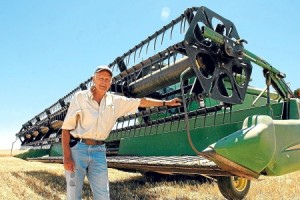As the World Turns, So Does Our ‘Beat’
Posted on September 29, 2015
Filed Under Communication, Technology, The Writing Life | Leave a Comment
A technical writer named Rebecca muses on the web about her choices of employment – and her freedom to make them. That, as we know, is one of the benefits of being a “lone wolf” technical writer.
“My long-term goal in becoming a technical communicator,” Rebecca writes, “is to be an outsourced employee, but without a larger ‘umbrella’ company sending me my W-2’s each year. I want to dictate the companies I work for and have some control over the projects I accept. I am comfortable putting on that ‘company’s uniform’ for a temporary time and then moving on.”
Rebecca quotes R. Stanley Dicks in Digital Literacy for Technical Communication: “Many more technical communicators will be officially unemployed but constantly working. They will be following the consulting/temp agency model that already characterizes the work of many communicators.”
Speaking for herself, Rebecca adds that “I am hoping to open a fortune cookie with just that prediction for my future: “You will soon find yourself unemployed, but always working.”
That’s not a paradox, it’s the work of a consultant, which many technical writers, including Encore’s Dennis Owen, actually are. Their roles are well-suited to an increasingly digital economy in a continuing state of emergence.
Dennis has been something of a pioneer in technical consulting, working in jobs where he’s been needed and can make important contributions, but not working these past few decades in a job. And the varied experiences he has had as a result have been invaluable.
Rebecca expresses something of the same sense of fulfillment: “The technical writing program I was set to enter was very solid and respected. But in 2001, it wasn’t very focused on digital media. Within a few short years, their ‘technical writing’ program became their ‘Technical Communications’ program. It was completely revamped several times over the next few years, as they slowly began to focus the program more on the emerging use of technology.
“Had I enrolled back in 2001,” Rebecca adds, “I would have been ‘getting to the party a little too early’.”
So roll with the opportunities as they arise in a steadily changing world. Like anyone else, actually, that’s what observant technical writers ought to be mindful of in these challenging times. It’s sort of like a newsman’s ‘beat’. – Doug Bedell
When to Pause to ‘Get It Down’?
Posted on September 18, 2015
Filed Under Communication, Technology, The Writing Life | Leave a Comment
Jim Grey on his Stories From the Software Salt Mines site makes a clearcut distinction that’s worth stamping into one’s awareness: “Personal computers are for content creators; mobile devices are for content consumers.” Or, creators – think desktop; consumers – think mobile.
 Makes pretty obvious sense – up to a point that seems to be approaching with increasing speed. The continuing development of iPads and other mobile devices tempts us to use them for creating content, not just reading or viewing it. (Apple says that, come November, its newest iPad will have an external keyboard available.)
Makes pretty obvious sense – up to a point that seems to be approaching with increasing speed. The continuing development of iPads and other mobile devices tempts us to use them for creating content, not just reading or viewing it. (Apple says that, come November, its newest iPad will have an external keyboard available.)
Technical writers likely are paying increasing attention to these distinctions, or to their increasing tendency to blur together. It would be nice to create serviceable copy wherever you have the ability to pause a bit, not only at your desktop, but, say, in the park. Your insights might well be sharper and your writing fresher. Using a mobile device is like having your brain more readily at hand, providing your fingers have ready access to what you’re thinking.
Mobile devices as “mere” displays allow us to take advantage of idle time. Jim Grey notes that “an Internet device in our pocket lets us pleasantly wile away the minutes we spend waiting — in doctors’ waiting rooms, before meetings begin, in the john.” But he’s not going to start blog posting on his phone.
Unless, we’d venture, Jim or any of us finds ourselves in a situation where it would be advantageous to get our thoughts down coherently because they’re especially important to us or maybe to others.
You see what’s happening here? The modes of expression are tending to merge with the availabilty of technology that can help that happen. Reflections that used to be random meditations can now be recorded musings – if and when we feel they’re significant enough. This can help make us more observant, as well as more reflective, and that’s all to the good, most of the time.
Remember the title of Jim Grey’s blog – “Stories from the Software Salt Mines.” We don’t want to feel that we’re living in a salt mine, just that we have the ability to use a mental pick and shovel when they’re occasionally advisable – for the record, say. Maybe we’d even get more sleep some nights. – Doug Bedell
Progress Promptings From a Roller Coaster
Posted on August 31, 2015
Filed Under Business, Communication, Technology, The Writing Life | Leave a Comment
One of the truly liberating aspects of a talent like technical writing is the ability to function with minimal support and oversight. That’s the setting you’re likely to find at a start-up company, so don’t overlook the advantages of working for a beckoning startup.
Tom Johnson, of I’d Rather Be Writing, asks: “What qualities should technical writers have to work at startups?” He answers by listing: Technical aptitude, Independence and leadership, Content strategy skills, Versatility and Stability.
Stability? Aside from coming to work each day at an agreed time, what’s that mean in terms of successful technical writing?
 “To ride the roller coaster of a startup,” Tom explains, “you need to have stability in your career, knowing that if your job dries up you can find another, or that you have savings to cover a period of unemployment during the transition, or that you can handle any changes and continue with the company, perhaps in another role entirely (e.g., support or training manager).”
“To ride the roller coaster of a startup,” Tom explains, “you need to have stability in your career, knowing that if your job dries up you can find another, or that you have savings to cover a period of unemployment during the transition, or that you can handle any changes and continue with the company, perhaps in another role entirely (e.g., support or training manager).”
Actually, as we discovered at a trip to our local, continually-evolving amusement park recently, the roller coaster was among the milder of the thrill rides. You’ve got to be prepared for anything that fate or fortune throw at you these days.
Underlying ability, interest and fortitude still contribute the most to your ability to keep your seat when things get turbulent which, at some point, they most likely will. Close your eyes (for a moment), hold on, circulate, observe and write well. Keep your hands on the car, not up in the air, as the non-achievers tend to do.
Okay, they’re just doing that out of exuberance (or maybe in defiance of fear). But it’s not exuberance that keeps you safely employed at today’s workplaces, or on behalf of today’s clients. It’s ability, vision and diligence. – Doug Bedell
Keep the Insights Churning
Posted on July 30, 2015
Filed Under Communication, Technology | Leave a Comment
Technical writers may not realize it, or always act on it, but they’re positioned to know a lot about their organizations, more, perhaps, than most of their colleagues. That’s because they’ve traveled their reaches looking for what we might call linking insights, and have mulled over those they’ve received.
 Craig Haiss on his HelpScribe blog is good at paying heed (and minding his manners) on his technical writing rounds.
Craig Haiss on his HelpScribe blog is good at paying heed (and minding his manners) on his technical writing rounds.
“There are ways,” he writes, “to infiltrate the minds of your coworkers and make an indelible impression of your worth. But you have to make a proactive effort.”
“Don’t let the routine lull you into an apathetic state,” Craig urges. “You job is not about what happens to you. You can meet your deadlines and still find ways to meet other key players in your business. Look for projects outside of your department that could benefit from you technology and communication skills.”
They you have it: Not everybody, far from everybody, in fact, has both technology and communication skills. Treasure what you’ve acquired, along with the instincts you were born with. If you’re not learning, you’re likely wasting the time you’re spending on your daily rounds.
Or maybe, by organizational fate or mistaken fiat, other departments are working on the same things you are. Should you note that, do something about it. “Payroll is pricey. Tools are pricey,” Craig notes. “When two or more people are documenting the same process with different tools, your company is losing money.”
That’s the style of an activist writer, not a mere transcriber of observations made on fitful rounds.
“Only you can help others realize how valuable an asset you are,” Craig notes. That’s true, but you have to act like an asset – by making connections others may be missing, and by noting needs and issues that may have been overlooked.
Yes, a technical writer functions, or should, in the mode of what the newspapers used to call a beat reporter. Newspapers are fading now, unfortunately. Don’t let that be the fate of your technical beat. Your organization can’t afford it, nor can you. – Doug Bedell
Metering Energy Efficiency
Posted on July 9, 2015
Filed Under Business, Technology | Leave a Comment
There’s a thoughtful article on energy efficiency – how to achieve and measure it, especially in households – on MIT’s Technology Review site. This post isn’t intended fully to resolve this important question, but to note MIT’s helpful information on it.

First off, American industries, as contrasted with homes, “have done a good job of becoming more (energy) efficient.” That’s not, of course, because homeowners and renters are perverse about energy savings, but that achieving them in significant volume is harder to do in households. So “overall energy consumption by households has continued to rise, according to the U.S. Energy Information Administration.”
Sentiments have sharpened since a study on weatherization assistance in Michigan households was released in June. Based on 30,000 households participating in the federal Weatherization Assistance Program (WAP), it showed that “The costs to deploy the efficiency upgrades were about double the energy savings.”
Gee, households are hopeless. Not really – “There’s plenty of counter-evidence,” the MIT review notes. Marshaling it is challenging, though. You need to measure “actual savings at the electricity meter.”
That’s what California is attempting to do: “Using data from electricity meters to track actual savings and adjust projections to match performance.” The state’s CalTRACK program is “using data from electricity meters to track actual savings and adjust projections to match performance. It’s “supported by environmental groups and utilities such as Pacific Gas & Electric and is based on the Open Energy Efficiency Meter, “a technology standard designed to help businesses, homeowners, utilities, and regulators reliably calculate the savings from energy efficiency projects.”
Monitoring energy use is challenging and MIT provides several links to source materials on the issues and prospects involved. They’re definitely worth pursuing by anyone seriously interested in energy efficiency, and we’re pleased to provide this lead into the matter. Metering’s the method, it appears. – Doug Bedell
Dr. Quick’s Knowledge Reaped World Harvests
Posted on June 24, 2015
Filed Under Communication, Technology | Leave a Comment
The vast range of human technical ingenuity is brought home, sadly, by the death of Dr. Graeme Ross Quick, an Australian whom most of us never heard of.
The Land, an Australian blog, advises that Dr. Quick “was an authority on harvesters, tractors and much more.” He died last month at the age of 79.
 An authority on harvesters? Don’t they just grind across a field, bringing in a crop? Not if you’re a farmer they don’t. They’re highly specialized pieces of technical equipment.
An authority on harvesters? Don’t they just grind across a field, bringing in a crop? Not if you’re a farmer they don’t. They’re highly specialized pieces of technical equipment.
What you come to know depends largely on where and how you’re raised, and what experiences and opportunities you’re exposed to. Dr. Quick was raised in Australia’s Victoria state and developed a fascination with farm equipment “on an uncle’s nearby farm where he helped stock sheaves and worked with a horse-drawn reaper and binder.”
Farm work “helped fund his studies for a University of Melbourne degree in mechanical engineering, also sparking a career-long interest in field equipment efficiency.” What you influence, thereby, is what you become increasingly attached to.
Graeme Quick and his wife, Marlene, moved with their three young boys to the U.S. in 1967, where he accepted an invitation to teach and study for a doctorate at Iowa State University. His later career took him to Norway, Canada, the Philippines (where he headed the International Rice Research Institute’s agricultural engineering division), and then to the United Nations Food and Agriculture Organisation (FAO). “His rice research and FAO projects,” the FarmOnLine writers add, “took him as far afield as Egypt, Pakistan, Bangladesh, Vietnam and Bhutan in the Himalayas.”
That all made him an international technical advisor in harvesting. Think how much of an increased yield resulted from his work! And he became the first Australian fellow of the American Society of Agricultural Engineers. Obviously, you don’t give accomplishments like these any thought if you’re not aware of them.
Finally, Dr. Quick received agricultural engineering’s highest recognition – the C.H. McCormick-J.L. Case gold medal “for meritorious contributions to the profession.”
How many such technically grounded men and women, largely unsung heroes and heroines of our times, do you know? Don’t you wish you knew more of them? Be alert to where they might be active in your field, and seek them out. In this Internet age, that’s becoming easier to do. You’ll grow together, harvesting wisdom. – Doug Bedell
Moreover, Writing Takes Time to Do Well
Posted on June 9, 2015
Filed Under Communication, Government, Technology, The Writing Life | Leave a Comment
Here’s Tom Johnson, the technical writer proprietor of “I’d Rather Be Writing,” trying to make amends – and offer cautions – for all our heedless brethren who aren’t so mindful that, after all, they’re dealing with human readers, even if they may have technical mindsets.
 Readers turn to a technical text to learn efficiently. But, too often, they’re imposed upon by writers who don’t take the time to be readily understood. Yes, coherent technical writing takes time, along with an understanding of its context.
Readers turn to a technical text to learn efficiently. But, too often, they’re imposed upon by writers who don’t take the time to be readily understood. Yes, coherent technical writing takes time, along with an understanding of its context.
The first thing we need to do, Tom notes, is to “decode complexity”. But if complexity is presented well, it can take less time to cope with – good technical writers take the time to save their readers time. (Their employers need to be mindful of that.)
Densely driven technical writers are prey to the main hazard of all heedless writers – they risk not being readily understood. Who would sit down to a keyboard these days and not want to be readily understood? Only reckless or inordinately pressurized souls. Be sure you own situation is fairly structured to allow you to read and write well. (Clue: Communication with managers may be required.)
Yet you also have to apply shoe leather. Part of being a good technical writer, Tom notes, is being an investigative reporter. You need to seek out information from its sources – the actual “doers” in your work setting.
“I set about asking engineers around me for information,” he writes. “Every time I talked to an engineer, I would get a firehose of useful information that would help me understand what was going on.” You’re there, basically, to slow down and aim the hose so that others don’t get sprayed with information.
Tom suggests that stepping through a task yourself, if you have the time, is a good idea – and you should have the time. (Again, supervisors please take note.)
And finally, the best advice: “Rest your brain. Sometimes,” Tom notes, “when I can’t figure something out, I sleep on it. In the morning, the answer comes to me.” Or simply take a break.” Indeed, a good cook will tell you that recipes can’t be rushed. Technical writing’s no different. – Doug Bedell
Mars Photos Keep Coming Over Those Millions of Miles (Make that Hundreds of Millions)
Posted on May 26, 2015
Filed Under Education, Technology | Leave a Comment

Go on a springtime tour of Mars, our Spring at least. The National Aeronautics and Space Agency (NASA) is posting a series of photos taken by its Curiosity Mars rover over periods of days and months. There are shots of Curiosity climbing a Martian mountain and even of “a serene sundown on Mars.” (Click on this photo for a sharper view.)
Such a photo gallery is a truly amazing accomplishment, considering that it’s coming from an average distance between Earth and Mars of 140 million miles. It may seem like wasteland, but put that into the context of the solar system, and what it took to get there and there is much to ponder about extra-spatial relationships.
Not content with the merely amazing, NASA recently reported that it has succeeded in sharpening the focus of Rover’s camera to get more sharply etched shots of the landscape there. How? By sending new software up there, of course.
Writing That Gets You From Here to There – Now as Then
Posted on May 11, 2015
Filed Under Communication, Technology, The Writing Life | Leave a Comment
Tom Johnson, a technical writer in San Jose, CA, has the right idea: He wants to be sure that technical writing is focused on the reader (that is, the user), not the equipment or processes being explained. They’re obviously important, but the reader is moreso. He or she has got to get it right – and readily so.
 Tom has started a new series on his I’d Rather Be Writing blog on user-centered design. That’s what all good writing should be: user-, that is, reader-, centered. It’s not the equipment or location that’s benefitting from clarity of expression – except residually (it can be damaged) – but the reader who’s seeking to use it properly. And he or she may be in too much of a hurry.
Tom has started a new series on his I’d Rather Be Writing blog on user-centered design. That’s what all good writing should be: user-, that is, reader-, centered. It’s not the equipment or location that’s benefitting from clarity of expression – except residually (it can be damaged) – but the reader who’s seeking to use it properly. And he or she may be in too much of a hurry.
All good writing puts the reader foremost. Not that writing needs to be overly simplified, but it needs to be engaging – or, in the case of technical writing, readily decipherable.
Tom Johnson has spent some time in usability labs watching users interact with his content and, he says, “it’s an eye-opening experience.” He’s got some links in his post relating to the labs, but he’s distilled 12 patterns from them. They include recognizing that users are often in a hurry, that they like visuals and that they don’t necessarily read in sequential order.
Meeting such human desires is indeed a challenge to technical writers, but those are your publics – human beings under pressures.
Tom Johnston writes not not so much about instructions for physical products as software documentation, which is his gig. Yet clarity applies as much to today’s cyber settings as it did to Thomas Hardy’s Wessex novels.
Tom Johnson urges his tech writing colleagues to design their documentation around his perceived patterns of user behavior. In listing them, he’s done a lot of your work for you. Take advantage of his accomplishments. – Doug Bedell
(Illustration: Simon Gatrell’s book “Thomas Hardy’s Vision of Wessex”)
Good Writing Requires Empathy Always
Posted on April 22, 2015
Filed Under Technology, The Writing Life | Leave a Comment

The craft of writing, technical or otherwise, is a demanding one – surely you’ve heard that?
Stephen Pinker, Johnstone Professor of Psychology at Harvard University and chairman of the Usage Panel of the American Heritage Dictionary, discusses that reality in a Wall Street Journal post. Only he attributes the difficulty to the wrong source, or at least doesn’t go deeply enough into the problem.
It’s not so much that writing is so much a demanding exercise as a somewhat deluding one. You’ve gotten those words onto paper, they flow before your eyes, so they must be the delightful outcome of a trying process. Oh, really?
The difficulty in writing well – so that your output isn’t opaque or appear as next-to-gibberish to someone else – is that you, the writer, may be lacking in a sense of empathy. Relax, that’s not fatal, but it takes awareness to correct. Empathy is best defined as walking in someone else’s shoes or, in this case, reading with someone else’s eyes. How am I coming across not to myself, but to my readers, should be every writer’s question, constantly.
Forget the recognition you may have justly earned for your accomplishments. When a page with your words on it is put before someone else, all that matters at that moment, besides the basic accuracy of your expression, is how well it connects with the reader, how well it informs or inspires others.
Pinker discusses bad writing in terms of the “bamboozlement theory” of written expression. “Pseudo intellectuals,” poor writers who consider themselves good ones, let themselves off the hook too easily – if they even realize that they’re on a hook.
“The curse of knowledge,” he writes, “is the single best explanation of why good people write bad prose. It simply doesn’t occur to the writer that her readers don’t know what she knows – that they haven’t mastered the argot of her guild, can’t divine the missing steps that seem too obvious to mention, have no way to visualize a scene that to her is as clear as day. And so the writer doesn’t bother to explain the jargon, or spell out the logic, or supply the necessary detail.”
In other words, he or she (sex doesn’t matter when prideful creation is underway) doesn’t empathize enough with the reader. “How am I coming across?,” “Am I being understood about what I’m trying to get across?” should be his or her recurring thought.
Walk in another’s shoes while writing and you may get to a different place than you intended, but you’ll have others with you. And it’s always great to have company, real companions, not simply assumed ones. – Doug Bedell
« go back — keep looking »Recently
- Presentations With Forethought
- Technical Writing’s Lineage – Surely It’s Deeper than Digital
- At the Holidays, Twitting Amazon
- Successful Cookie Baking – From Mom, an Acknowledged Expert
- Slides for a Tech Writer’s Craft
- Digital or Not, Be Clear
- Being Watchful About Digital Designs…
- When Proposals Don’t Click, Keep Making Them Anyway
- Like a Good Gardener, Help an Enterprise Keep Itself Current
- We’re Leaders All, And Need to Think That Way
Categories
Archives
- January 2017
- December 2016
- November 2016
- October 2016
- September 2016
- August 2016
- July 2016
- June 2016
- May 2016
- April 2016
- March 2016
- February 2016
- January 2016
- December 2015
- November 2015
- October 2015
- September 2015
- August 2015
- July 2015
- June 2015
- May 2015
- April 2015
- March 2015
- February 2015
- January 2015
- December 2014
- November 2014
- October 2014
- March 2014
- February 2014
- January 2014
- December 2013
- November 2013
- October 2013
- September 2013
- August 2013
- July 2013
- June 2013
- May 2013
- April 2013
- March 2013
- February 2013
- January 2013
- December 2012
- November 2012
- October 2012
- September 2012
- August 2012
- July 2012
- June 2012
- May 2012
- April 2012
- March 2012
- February 2012
- January 2012
- December 2011
- November 2011
- October 2011
- September 2011
- August 2011
- July 2011
- June 2011
- May 2011
- April 2011
- March 2011
- February 2011
- January 2011
- December 2010
- November 2010
- October 2010
- September 2010
- August 2010
- July 2010
- June 2010
- May 2010
- April 2010
- March 2010
- February 2010
- January 2010
